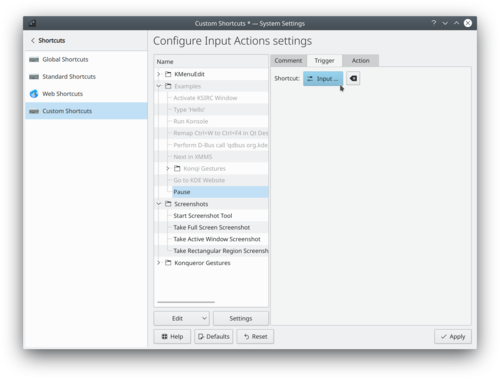Tutorials/hotkeys: Difference between revisions
m (don't open a new terminal emulator, just to open the system settings) |
m (remove obsolete commands, prefer dbus instead of kde4 commands) |
||
| Line 24: | Line 24: | ||
<!--T:9--> | <!--T:9--> | ||
* Enter | * Enter {{Input|1=qdbus org.kde.screensaver /ScreenSaver org.freedesktop.ScreenSaver.Lock}} | ||
{{Input|1=qdbus org.kde.screensaver /ScreenSaver org.freedesktop.ScreenSaver.Lock | |||
<!--T:10--> | <!--T:10--> | ||
Latest revision as of 13:23, 20 April 2019
With KDE you can set any key or a combination of keys to trigger an action on your computer. As an example: when I pause my work I want to lock my screen with the Pause key so my colleagues cannot baggy-pants me. Here is how to do that.
- Open the System Settings
- Select → → → → → and enter
Pause
- In the tab, click on
- Press the Pause key
- Go to the tab
- Enter
qdbus org.kde.screensaver /ScreenSaver org.freedesktop.ScreenSaver.Lock
- Click
- test it by pressing the Pause key

